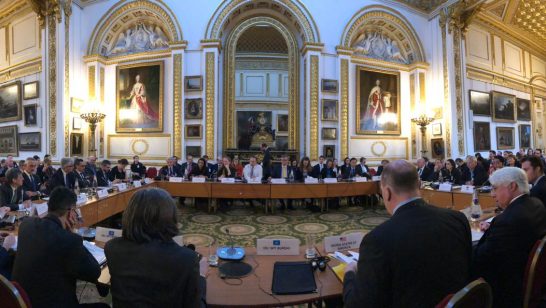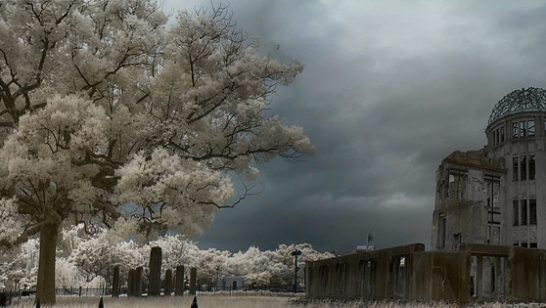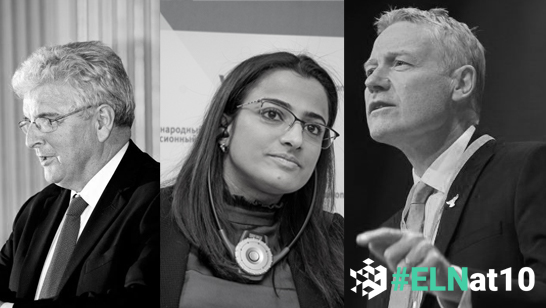
In May, the ELN’s Director, Sir Adam Thomson, spoke at the 2023 Effective Altruism conference in London on the nature of the catastrophic and existential risks we face, including nuclear risks. He discusses how they are meaningfully different from those of 60 years ago, and how we should reassess how we tackle the single greatest driver of them, great power competition. You can read Sir Adam’s speech below and watch it here.
- Thank you. I am very grateful for this opportunity. Preparing these remarks has helped me develop my thinking. I hope our discussion will take things further.
- I’m simply a former practitioner and current mitigator of great power risk. Moreover, I plan to speak for only 35 minutes before Sim opens the floor to you. So I cannot offer the rigorous analysis of a moral philosopher or an international relations theorist. But, for reasons I will argue, the practitioner’s view counts for something in this area
- In “The Precipice” Toby Ord writes that great power competition is a greater driver of existential risk than all natural risks combined. I’d go further and argue that great power competition is the single greatest driver of anthropogenic existential risk.
Great power competition is the single greatest driver of anthropogenic existential risk. Adam Thomson
Not just because of the direct risk of great power war but because great power competition is such a massive risk factor. Think about it: great powers generate the existentially risky technologies; they are the states most likely to deploy them; their confrontations drive the risks of use; they are central to multilateral risk reduction, and yet they can and do block it, for example on arms control or climate change.
Whatever the exact probabilities, if I’m right, then getting traction on great power risk ought to be an extremely high priority for the EA community. There’s been some useful attention to modelling great power war, less attention to modelling great power dynamics as a risk factor, and almost no attention that I know of to what I want to focus on – the question of tractability. Tractability is, in Toby Ord’s terms, a neglected risk.
For me, tractability is a personal problem, not just a policy one: my organisation, the European Leadership Network, is dedicated to the prevention of existential conflict in Europe and beyond. If I cannot show that what we do has traction, we’ll go out of business – and deserve to do so. Getting traction on great power risk is, therefore, something we think hard about.
- So that’s the first of my general points: great power risk is important and doing something about it is neglected. Neglected not just by the EA community, who probably think getting traction is too hard, but neglected by the great powers themselves, to the intense frustration of the rest of the international community.
- Now I want to offer four further highly compressed framing points about traction and then try to derive five practical recommendations for getting it.
- My next framing point is to acknowledge that getting traction on great power risk is not only hard but getting harder.
If you think of this in terms of locking in positive dynamics for humanity’s long-term future then, as matters stand, with each passing year, we are at greater risk of getting locked out. Not just because relations between the West, Russia and China or India and Pakistan or in the Middle East are awful, highly dangerous, and difficult to overcome but for more structural reasons.
As time passes and technologies proliferate, there will be more and more key state and non-state players to be involved in negotiating risk reduction. Adam Thomson
As time passes and technologies proliferate, there will be more and more key state and non-state players to be involved in negotiating risk reduction. There will be more and more technologies with a direct or indirect bearing on existential risk to be factored in. And, on current trends, there will be more and more entanglement and interplay between these technologies and these risks to be considered.
The challenges of even nuclear risk reduction are an order of magnitude more complex than 60 years ago in the aftermath of the Cuban Missile Crisis. Simplistically, then there was one risk (nuclear), two actors (Washington and Moscow), and no technologies impacting the decision-making except the difficulty of communication. Now at least climate, AI and nuclear are in a complex dance, there are nine nuclear states, and deep fakes, spoofing, AI, hypersonics, cyber and a half dozen more technologies could impact nuclear decision-making in a crisis. In this respect, nuclear, too, is a neglected risk.
- So my third framing point is really important: TRACTION IS STILL POSSIBLE! This is really important. The feeling of hopelessness – that it’s all too difficult and that we as individuals cannot make a difference – is the biggest turn-off to engagement.
But if indeed great powers competition is the single greatest driver of anthropogenic risk, then, at the moment, we’re in luck.
There are very few great powers. For the moment, they control most current and near-future existential risk. And if the United States, China and Russia acted to reduce the existentially risky dynamics between them, that would make lesser risks between them more manageable and make it a lot easier for other existentially risky states to follow suit. So we only need traction on a small number of key states in order to reduce a huge chunk of existential risk.
We only need traction on a small number of key states in order to reduce a huge chunk of existential risk. Adam Thomson
Moreover, we aren’t talking about trying to end all great power competition or even confrontation. We only need traction on the existential risks. Historically, there has been traction on nuclear – in bad times as well as good. And there is very recent evidence of continuing nuclear traction. Last January the leaders of China, France, Russia, the United States and the United Kingdom collectively declared that the avoidance of war between nuclear powers and the pursuit of strategic risk reduction were their “foremost responsibilities” as leaders. The ELN played the leading NGO role in securing that declaration. More recently, when the US, China and India piled in on Putin last October, he drew back on threats of nuclear use.
- My fourth framing thought is that governments are a problem. If you want to improve traction on existential risk, for goodness’ sake, don’t leave it just to governments.
If you want to improve traction on existential risk, for goodness’ sake, don’t leave it just to governments. Adam Thomson
Yes, governments are indispensable to traction: only states take the big security decisions, and what we want is traction on those decisions. But great power dynamics make it uniquely hard for governments:
The great powers sit astride deeply emotional historical divides. Nuclear and, in future, other existential deterrence allows those emotions to be nursed and rallied in sometimes jingoistic nationalism. They can and do ignore the rest of the world. Worse, existential capabilities are part of national identity. As the Ukraine war shows, precisely because great powers have such capabilities, they do risky, coercive things.
What’s in it for them to give up such capabilities? Here’s where practitioners like the ELN come in. If you haven’t done the diplomacy, where are you going to find the answers?
- So my final framing thought is about effective altruism and the art of the possible.
I just don’t think EA is paying enough attention to diplomacy. The mathematical clarity of Newtonian longtermism starts to buckle into relativity and quantum mechanics the closer the space-time continuum gets to the present.
And I just don’t think EA is paying enough attention to the reality that, if existential risk is to be reduced peacefully rather than by catastrophe, it must be reduced across ALL the owners of the existential means because if any single one holds out, none of the others will give up their own capability. We focus too much on Western solutions and not on what works for Russia or China.
We focus too much on Western solutions and not on what works for Russia or China. Adam Thomson
Just for examples, what if you have to choose, as we currently do, between keeping Russian and Western minds open to each other for possible long-term traction or making the confrontation over Ukraine worse in the short term in order to make it sufficiently painful that the adversary doesn’t do it again? For that matter, what are the ethics of pursuing existential risk reduction with an accused war criminal?
Once again, there may be a role for practitioners of international politics and diplomacy, people who understand their own side and the adversary and can speak with both.
- To sum up, great power risk is important, it is tractable, the art of traction is neglected, time is short, the dynamics are a real problem, and even heuristics may take you only so far.
- So, as a practitioner, what steps do I recommend for traction?
- I recommend five practical steps:
First – a serious point – take a deep breath and acquire both strategic patience and resilience against setbacks. There are no silver bullets like bed nets for malaria. This is not just for the long haul, it is forever.
Second, because the traction problem is hard and getting worse, please commit EA brainpower and resources to it. You are international, multidisciplinary and fresh thinking, where government and even NGO approaches to great power risk reduction are siloed, stale, and thus almost by definition inadequate to the task.
Third, mobilise your EA network. Because governments are necessary but not sufficient, embrace and support the power of non-governmental networks. Networks can think thoughts, float ideas, say things, convene people, go places and build bridges in ways that governments simply cannot. Because existential risk reduction has to be for the long haul, institutionalise networks of NGO networks around the globe. For example, create an international civil society organisation under the UN umbrella for the regulation of great power competition, like the Global Compact does for business.
Now for a short commercial break to illustrate this network point! The ELN is an independent, non-partisan, intergenerational, pan-European network of some 400 experienced and emerging leaders from virtually all Euro-Atlantic countries who are committed to the prevention of existential conflict. Between them and their sister Asia-Pacific network, they speak all the great power languages, have worked in all the great power governments, are influential in their media and societies, and can access all the great power leaders. The strength of their non-governmental guerrilla diplomacy lies in their diversity: they range from former NATO Secretaries General and Russian military intelligence generals to businesspeople, economists, AI experts and disinformation combatants. They agree on little except the need for greater mutual security. My team’s job is to create coalitions of network members willing to work to achieve that greater security. The potential for traction in support of, alongside and despite governments is extraordinary and unique.
The strength of the ELN lies in our diversity: our network ranges from former NATO Secretaries General and Russian military intelligence generals to businesspeople, economists, AI experts and disinformation combatants. Adam Thomson
Fourth, alongside tools for traction you need ideas. Right now, the scope for traction is sharply narrowed by dangerous ideas about how to do great power confrontation. Because risk reduction is the art of the possible, we need to expand what is possible by countering these ideas and promoting enabling ideas about what might be called “existential diplomacy”.
I am not Panglossian. I don’t believe great power competition will ever disappear. States have a duty to their citizens to hang tough – it’s a mean world out there. If you neglect the reality of human competition and instinct for war, your diplomacy will be trampled in the dust of your adversary’s invasion.
But states also have a duty not to exterminate their citizens. If great powers just focus on deterring their adversaries with all their existential capabilities without diplomacy in the service of existential risk reduction, they cannot hope to live indefinitely without existential catastrophe.
What does this re-engineered existential diplomacy look like?
- Insulate existential risk reduction from the rest of great power competition. In time for this weekend’s G7 summit, the ELN and APLN have launched an appeal from 248 thought leaders in 50 states, including Russia, China, the USA, India, Pakistan, the UK and France, to protect nuclear arms control.
- Skewer the bad ideas that block traction: historical myths, essentialism, collective punishment of populations (especially in autocratic states), and anthropomorphic foreign policy (where you treat states as if they were individuals and cut off communication when your adversary behaves badly).
- Promote ideas more likely to deliver traction: effective altruism (!); structured, all-weather communication between adversaries; the importance of understanding the adversary and yourself for the sake of mutual survival; the fact that deterrence can be pursued at lower risk and lower cost through arms control. Encourage statesmanship and admiration for diplomacy.
It is crazy that most of these ideas are so deeply unfashionable – pretty much on all sides. That’s not because they are unrealistic or inevitable. 30 years ago they were common currency.
Fifth and finally, because traction grows with evidence of traction, alongside tools and ideas for traction, you need implementation. So in parallel to building the mindsets necessary for existential diplomacy, use your networks to push for great power risk reduction. Risk reduction is diplomacy. And vice versa:
- Diplomacy teaches that sequencing matters. And right now, putting in place the concepts comes ahead of early arms control. So perhaps we should next get P5 leaders to broaden their January 2022 declaration about nuclear risk with one declaring that “existential war cannot be won, must never be fought, and is a shared threat to be countered”. Work to persuade the P5 that if they do not themselves control the existential risks, others will acquire the existential means to coerce them. They have an increasingly pressing shared interest in building on the 1968 Nuclear Non-Proliferation Treaty with a Treaty on the Non-Proliferation of Existential Risk.
- When it comes to implementation, start with what great powers know roughly how to do. Climate risk reduction may be less politicised and more visual than nuclear. But there’s a longer track record of nuclear arms control. Nuclear is the currency in which great powers still deal. It is more easily verifiable than AI or bio. And it, rather than climate, is more likely to unlock pathways to bio and AI risk reduction. So personally, I think it is crazy that in the EA world so few organisations, such as Longview, are working on nuclear. It is massively under-resourced compared to AI, climate, or even bio.
Nuclear is the currency in which great powers still deal. It is more easily verifiable than AI or bio. And it, rather than climate, is more likely to unlock pathways to bio and AI risk reduction. Adam Thomson
- Finally, build the human capacity for negotiation and arms control. Work through and protect the existing institutions of international governance and risk reduction – the UN for all its faults, the IAEA, the BTWC despite its shortcomings, the climate change summits. Be prepared to reform them for greater inclusion, agility and relevance if and when the adversary can convince you that this is for stability, not advantage. Build the new institutions – national and international – that decade after decade will lock in safer international behaviours with regard to catastrophic and existential risk and close the gate against more dangerous paths.
Does all this sound hard? That’s because it is. But remember the good news: things could be a whole lot worse – and if we don’t act, they probably will be. Finally, hold on to one further bit of good news. Wicked problems are ones where you don’t even know what the question is. Getting traction on great power competition may be a knotty problem. But it is not a wicked one.
Adam Thomson
European Leadership Network
20 May 2023
The opinions articulated above represent the views of the author(s) and do not necessarily reflect the position of the European Leadership Network or any of its members. The ELN’s aim is to encourage debates that will help develop Europe’s capacity to address the pressing foreign, defence, and security policy challenges of our time.
Image: Screengrab, YouTube, Centre for Effective



